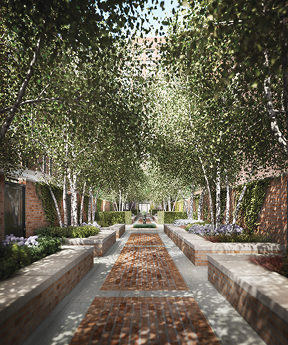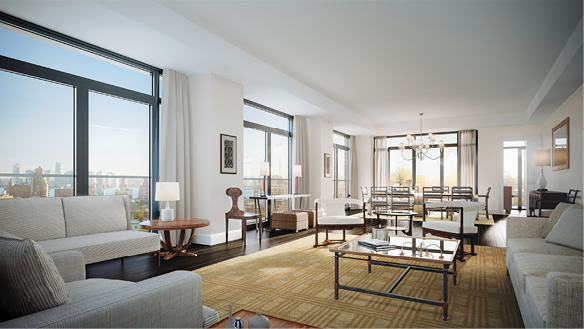


![]()
ONLINE

The Rudin Way
Editors’ Note
William Rudin is Vice Chairman and CEO of Rudin Management Company, Inc. Rudin was recently elected Chairman of the Real Estate Roundtable, and he serves on the Executive Committee of the Real Estate Board of New York. He is the Chairman of the Association for a Better New York and the Battery Conservancy. Rudin serves on the boards of New York University, the Metropolitan Museum of Art, the Partnership for New York City, the Economic Club of New York, the Alliance for Downtown New York, and the Citizen’s Budget Commission.
Company Brief
New York-based Rudin Management Company, Inc. (rudin.com) was founded in 1925 and operates one of the largest and most respected private real estate portfolios in New York, comprising 16 office towers and 20 luxury apartment buildings. Rudin family projects include the currently under construction residential development in the West Village, the Greenwich Lane, as well as 211 E. 70th Street and 215 E. 68th Street. The company’s commercial portfolio includes the Thomson Reuters’ North American headquarters at 3 Times Square, 32 Avenue of the Americas, One Battery Park Plaza, and 345 Park Avenue, the family’s flagship two million-square-foot office tower.
How have you maintained such a strong standing in the market over the years?
We call it the Rudin Way and it’s something my grandfather, Sam Rudin, started when he founded the company in 1925. After World War II, his two sons, Jack and Lewis, came into the business.
Sam built our business with a philosophy of creating developments of the highest quality, providing the best level of service to his customers, keeping conservative capital structure with low leverage, and innovating with state-of-the-art technology. Our business was always fundamentally urban. If Sam couldn’t get somewhere by subway, he was not going to buy it. When we built office towers in those early years, we usually built a residential building nearby. Sam was forward-thinking, and understood the power of urbanization and its effect on our business.
Jack and Lew continued that philosophy and brought their own sensibilities to the business. In the late ’70s, when my generation came to the business, we, too, brought our perspective and built upon the foundation that had been created. Now we are thrilled that my daughter Samantha and son Michael are actively engaged in our business. They are bringing a new outlook to the table and are an integral part of our current projects. Each generation in my family has been able to take the established foundation and add on new thinking about design and innovation that make our business better and more adaptable.

A glimpse at a portion of the 14,000-square-foot
private courtyard garden at
The Greenwich Lane
How strong are the commercial and residential markets today and is it sustainable long term?
In New York, the markets are very strong. We are currently in the construction phase of building the most complex project we’ve ever done, The Greenwich Lane. It’s an investment of more than $1 billion in the city’s largest adaptive re-use project to date, and includes Manhattan’s first free-standing emergency department. What we’ve created at The Greenwich Lane is truly unique, especially in the West Village, one of the most sought-after neighborhoods in Manhattan. The Greenwich Lane is five buildings and five townhouses – 200 homes in total, each designed by renowned interior designer Thomas O’Brien. Each building has a meticulously crafted design, and they are all joined together by a lushly landscaped 14,000-square-foot private courtyard garden and an incredible amenities package that includes a state-of-the-art fitness center, indoor pool, guest chef’s kitchen and dining room, golf simulator room, and more. Additionally, through the hard work of our architecture team at FX Fowle, The Greenwich Lane is on track to be the first Manhattan development certified LEED-ND, a special designation for environmentally friendly neighborhood development.
An important statistic for our development is that in the first 10 months, 60 percent of apartments have been sold – about 120 apartments – and more than 70 percent of those were to New Yorkers. This reinforces our belief that our unique product is what the market has been looking for in the heart of the West Village.
Our project is one example of creative, community-responsive development, and these projects are underway throughout the city. We believe that the fundamentals in New York have never been stronger, and this growth is sustainable if we don’t overtax ourselves, we work together with Mayor de Blasio to create affordable housing, we invest in infrastructure and education, and we continue to drive crime down.
It seems that much of the New York market is being priced out. Does this concern you?
Yes, and it’s why Mayor de Blasio is working with all the stakeholders to create more affordable housing. It’s a very complex issue, and we have to work together to figure out how to best allocate scarce dollars and keep the city affordable.
A great example is lower Manhattan: 15 years ago, there were 10,000 people living downtown; today, there are 60,000. This is the result of a combination of tax incentives and zoning changes that led to a change in the whole dynamic of downtown. We are confident the de Blasio Administration will bring this kind of creativity to continue to address the development issues throughout the five boroughs.
Private companies are becoming smarter and more innovative at addressing affordability issues, too. Earlier this year, we announced a collaboration with WeWork at our building at 110 Wall Street. WeWork is at the forefront of the shared economy, and is a new real estate model that provides affordable, flexible spaces to young, start-up, and creative companies. We’re excited to welcome them to 110 Wall Street to create the very first WeLive, which will extend the WeWork model to living space with smaller, hip apartments that are more affordable for young people. The lower floors of the building will house WeWork space. WeWork is lowering the barriers to entry to living and working in the city by making residential and commercial space more flexible and more affordable.

Rendering of a living room at 155 West 11th Street,
the tallest building in The Greenwich Lane development.
Is this a time for opportunity?
Yes. These efforts I described from the public and private sectors, as well as the increasing livability of the city overall, have opened up new neighborhoods for development and created tremendous opportunity in the far reaches of Manhattan, as well as the outer boroughs. Zoning changes have unlocked new value in many parts of the city, and I think we’re just starting to see the positive impact this will have on our economy, job creation, and the energy and dynamism of the city.
We’re optimistic. The city is doing great. But we have to make sure we cover our downside, so we try to do one or two projects at a time, to not extend ourselves too far, and to maintain our existing portfolio. We work every day to follow the Rudin Way.•